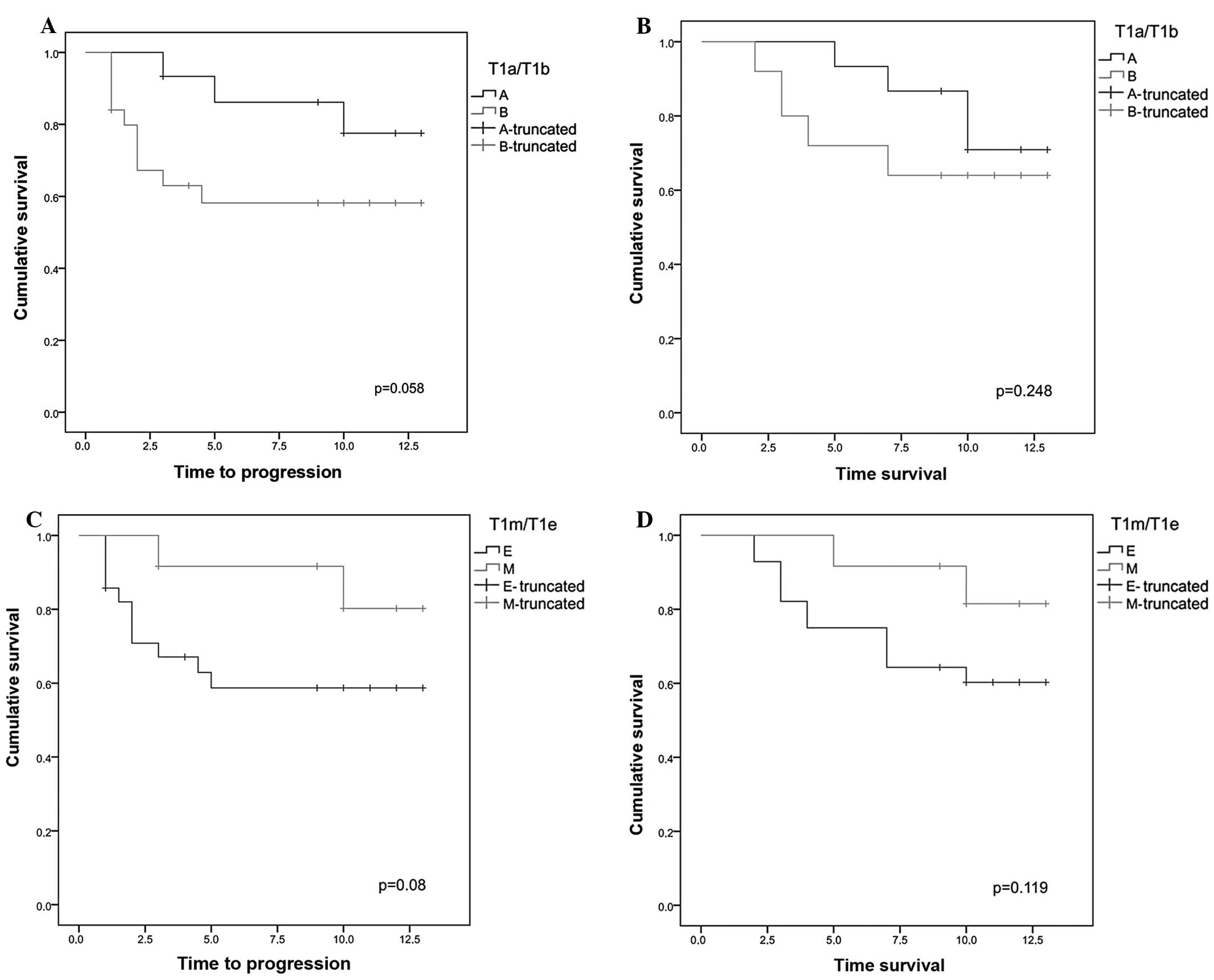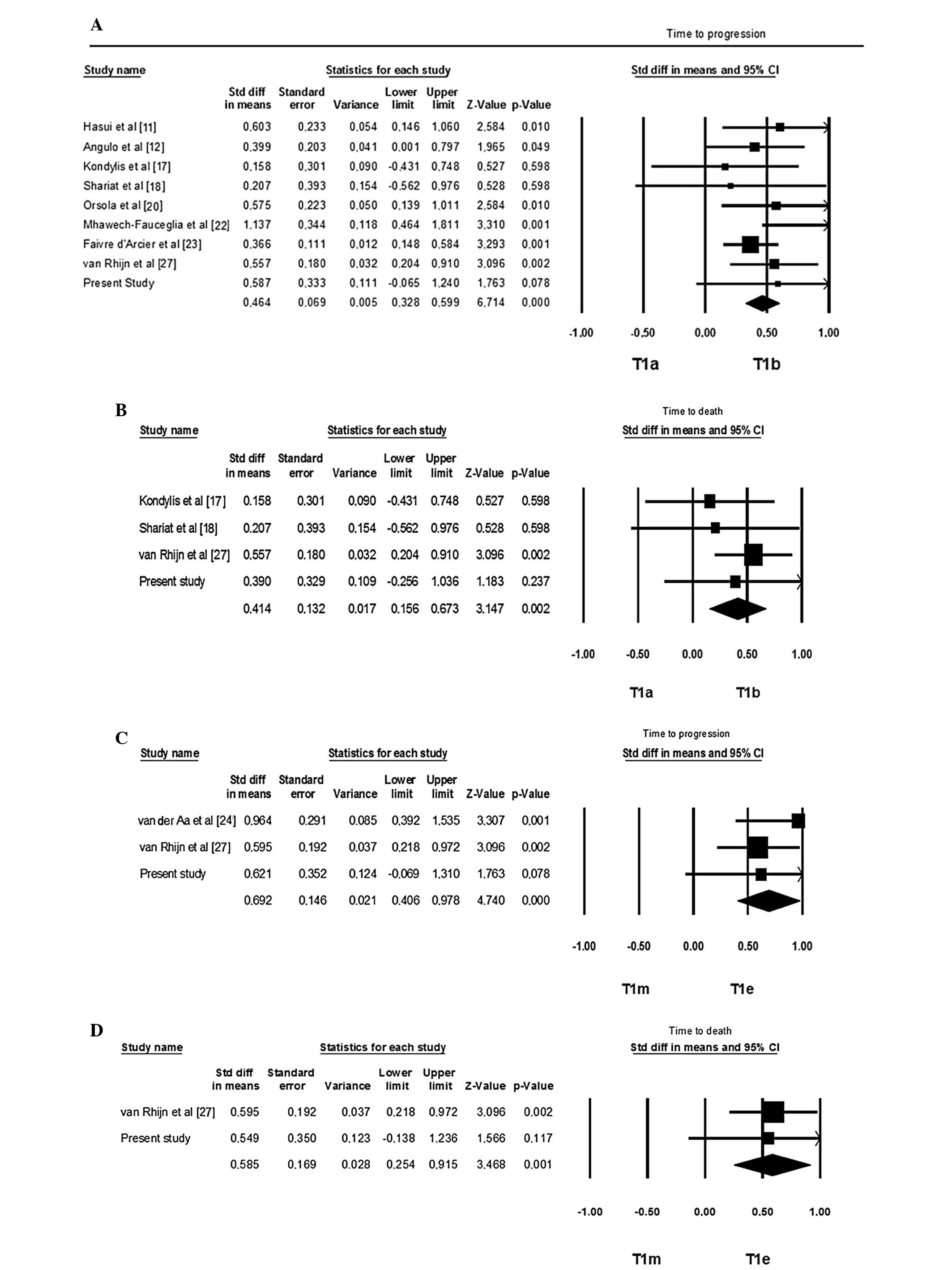|
1
|
Anastasiadis A and de Reijke TM: Best
practice in the treatment of nonmuscle invasive bladder cancer.
Ther Adv Urol. 4:13–32. 2012. View Article : Google Scholar
|
|
2
|
Sylvester RJ, van der Meijden AP,
Oosterlinck W, et al: Predicting recurrence and progression in
individual patients with stage Ta T1 bladder cancer using EORTC
risk tables: a combined analysis of 2596 patients from seven EORTC
trials. Eur Urol. 49:466–477. 2006. View Article : Google Scholar
|
|
3
|
van Rhijn BW, Burger M, Lotan Y, et al:
Recurrence and progression of disease in non-muscle-invasive
bladder cancer: from epidemiology to treatment strategy. Eur Urol.
56:430–442. 2009.PubMed/NCBI
|
|
4
|
Sylvester RJ, van der Meijden AP and Lamm
DL: Intravesical bacillus Calmette-Guerin reduces the risk of
progression in patients with superficial bladder cancer: a
meta-analysis of the published results of randomized clinical
trials. J Urol. 168:1964–1970. 2002. View Article : Google Scholar
|
|
5
|
Babjuk M, Oosterlinck W, Sylvester R, et
al: EAU guidelines on non-muscle-invasive urothelial carcinoma of
the bladder, the 2011 update. Eur Urol. 59:997–1008. 2011.
View Article : Google Scholar : PubMed/NCBI
|
|
6
|
Herr HW: Is maintenance Bacillus
Calmette-Guérin really necessary? Eur Urol. 54:971–973. 2008.
|
|
7
|
Stein JP: Indications for early
cystectomy. Urology. 62:591–595. 2003. View Article : Google Scholar : PubMed/NCBI
|
|
8
|
Schrier BP, Hollander MP, van Rhijn BW,
Kiemeney LA and Witjes JA: Prognosis of muscle-invasive bladder
cancer: difference between primary and progressive tumours and
implications for therapy. Eur Urol. 45:292–296. 2004. View Article : Google Scholar
|
|
9
|
Stein JP and Penson DF: Invasive T1
bladder cancer: indications and rationale for radical cystectomy.
BJU Int. 102:270–275. 2008. View Article : Google Scholar : PubMed/NCBI
|
|
10
|
Younes M, Sussman J and True LD: The
usefulness of the level of the muscularis mucosae in the staging of
invasive transitional cell carcinoma of the urinary bladder.
Cancer. 66:543–548. 1990. View Article : Google Scholar : PubMed/NCBI
|
|
11
|
Hasui Y, Osada Y, Kitada S, et al:
Significance of invasion to the muscularis mucosae on the
progression of superficial bladder cancer. Urology. 43:782–786.
1994. View Article : Google Scholar : PubMed/NCBI
|
|
12
|
Angulo JC, Lopez JI, Grignon DJ, et al:
Muscularis mucosa differentiates two populations with different
prognosis in stage T1 bladder cancer. Urology. 45:47–53. 1995.
View Article : Google Scholar : PubMed/NCBI
|
|
13
|
Platz CE, Cohen MB, Jones MP, et al: Is
microstaging of early invasive cancer of the urinary bladder
possible or useful? Mod Pathol. 9:1035–1039. 1996.PubMed/NCBI
|
|
14
|
Holmang S, Hedelin H, Anderstrom C, et al:
The importance of the depth of invasion in stage T1 bladder
carcinoma: a prospective cohort study. J Urol. 157:800–804. 1997.
View Article : Google Scholar : PubMed/NCBI
|
|
15
|
Smits G, Schaafsma E, Kiemeney L, et al:
Microstaging of pT1 transitional cell carcinoma of the bladder:
identification of subgroups with distinct risks of progression.
Urology. 52:1009–1014. 1998. View Article : Google Scholar : PubMed/NCBI
|
|
16
|
Hermann GG, Horn T and Steven K: The
influence of the level of lamina propria invasion and the
prevalence of p53 nuclear accumulation on survival in stage T1
transitional cell bladder cancer. J Urol. 159:91–94. 1998.
View Article : Google Scholar : PubMed/NCBI
|
|
17
|
Kondylis FI, Demirci S, Ladaga L, et al:
Outcomes after intravesical bacillus Calmette-Guerin are not
affected by substaging of high grade T1 transitional cell
carcinoma. J Urol. 163:1120–1123. 2000. View Article : Google Scholar : PubMed/NCBI
|
|
18
|
Shariat SF, Weizer AZ, Green A, et al:
Prognostic value of p53 nuclear accumulation and histopathologic
features in T1 transitional cell carcinoma of the urinary bladder.
Urology. 56:735–740. 2000. View Article : Google Scholar : PubMed/NCBI
|
|
19
|
Bernardini S, Billerey C, Martin M, et al:
The predictive value of muscularis mucosae invasion and p53 over
expression on progression of stage T1 bladder carcinoma. J Urol.
165:42–46. 2001. View Article : Google Scholar : PubMed/NCBI
|
|
20
|
Orsola A, Trias I, Raventos CX, et al:
Initial high-grade T1 urothelial cell carcinoma: feasibility and
prognostic significance of lamina propria invasion microstaging
(T1a/b/c) in BCG-treated and BCG-non-treated patients. Eur Urol.
48:231–238. 2005. View Article : Google Scholar : PubMed/NCBI
|
|
21
|
Andius P, Johansson SL and Holmang S:
Prognostic factors in stage T1 bladder cancer: tumor pattern (solid
or papillary) and vascular invasion more important than depth of
invasion. Urology. 70:758–762. 2007. View Article : Google Scholar : PubMed/NCBI
|
|
22
|
Mhawech-Fauceglia P, Fischer G, Alvarez V
Jr, et al: Predicting outcome in minimally invasive (T1a and T1b)
urothelial bladder carcinoma using a panel of biomarkers: a high
throughput tissue microarray analysis. BJU Int. 100:1182–1187.
2007.PubMed/NCBI
|
|
23
|
Faivre d’Arcier B, Celhay O, Safsaf A, et
al: T1 bladder carcinoma: prognostic value of the muscularis
mucosae invasion (T1a/T1b). A multicenter study by the French
Urological Association (CCAFU). Prog Urol. 20:440–449. 2010.(In
French).
|
|
24
|
van der Aa MN, van Leenders GJ, Steyerberg
EW, et al: A new system for substaging pT1 papillary bladder
cancer: a prognostic evaluation. Hum Pathol. 36:981–986.
2005.PubMed/NCBI
|
|
25
|
Cheng L, Neumann RM, Weaver AL, et al:
Predicting cancer progression in patients with stage T1 bladder
carcinoma. J Clin Oncol. 17:3182–3187. 1999.PubMed/NCBI
|
|
26
|
van Rhijn BW, van der Kwast TH,
Kakiashvili D, et al: Pathological stage review is indicated in
primary pT1 bladder cancer. BJU Int. 106:206–211. 2010.
|
|
27
|
van Rhijn BW, van der Kwast TH, Alkhateeb
SS, et al: A new and higly prognostic system to discern T1 bladder
cancer substage. Eur Urol. 61:378–384. 2012.
|
|
28
|
Nieder AM, Brausi M, Lamm D, et al:
Management of stage T1 tumors of the bladder: International
Consensus Panel. Urology. 66(Suppl 1): 108–125. 2005. View Article : Google Scholar : PubMed/NCBI
|
|
29
|
Eble J, Sauter G, Epstein JI and
Sesterhenn IA: Pathology and Genetics of Tumours of the Urinary
System and Male Genital Organs. IARC Press; Lyon: 2004
|











